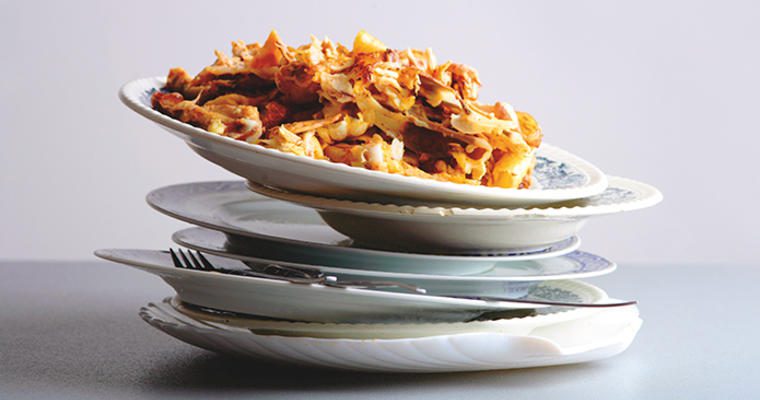When you’re serving hundreds or even thousands of meals a day, a little food waste here or there can add up. And waste is just another word for cost. In healthcare and senior-living foodservice, where there’s always pressure to cut costs, reducing food waste is a smart way to economize.
One of the biggest challenges is to figure out where food waste is occurring. When you scrape food from a plate into the trash, you don’t always know the reason. Did the diner have a poor appetite? Was the portion size too large? Did the food quality miss the mark? Just as there are many moving parts in your operation, there are many reasons for food waste and many ways to monitor it.
Statistics show 4 to 10 percent of food purchased is thrown out before it ever reaches the table. Add to that the amount of food tossed in the trash after meal service and it’s easy to understand how food waste can be expensive. There’s no way to eliminate all food waste, of course, but there are easy-to-employ practices that can help your bottom line.
Get the full food waste picture
Measuring food waste is a great beginning. Start a waste log, where everything is weighed, measured and charted, then regularly discussed with your staff and written down before being discarded. For your prep kitchen, this means weighing items before and after trimming. Track the fat or bones removed from center-of-the-plate proteins as well as the trimmings and blemishes cut away from produce. In addition to measurements, consider photographing the waste. The data and visuals are valuable when setting waste reduction goals and gauging improvement.
At Reid Health in Richmond, Indiana, the tracking process led to a 15 percent savings on food costs, according to Kris Ankeny, MS, RD, CD, Director of Food & Nutrition Services.
She says the 207-bed hospital, which serves 3,600 meals a day to patients, staff and guests, always tracked overproduction and underproduction in general terms. Adjustments were made without serious analysis. The amount of waste wasn’t clear until her operation started a food-rescue program to donate usable food to charity.
“Our waste was great for the soup kitchen, but not for our food production,” she says.
Make menu modifications
When waste is analyzed, you learn a lot about which foods are popular, Ankeny points out. That can lead to meaningful menu changes, both for the consumers and for the food budget.
“When we saw what we had left over, we modified meal counts and recipes,” she says. One change shortened the cycle menu from four weeks to two weeks at one of the hospital’s hot food stations, which was generating a lot of overproduction. “This has enabled us to keep a lot of different food choice options available but cut down waste.”
Other changes affected the hospital’s café, which conducts 1,500 transactions daily. Ankeny learned soups were going to waste, so now there are two soup selections instead of three. The cookie variety was reduced from seven to four, and she found there was no need for a hot dessert option every day. “So far, we haven’t had one complaint.”
Minimize or utilize: the leftovers solution
Proper storage, including monitoring the temperature of your cooler and labelling and dating foods to prevent spoilage, can reduce waste before it gets to the plate. But you still may be buying more than you need.
At Reid Health, Ankeny noticed an overproduction of steamed vegetables, so she started buying 2-pound frozen bags instead of 25-pound bulk boxes. The cost difference was minimal, and the efficiency of preparing smaller batches as needed resulted in fresher-tasting vegetables and less waste.
Another method of reducing overproduction could be buying value-added products. Pre-cooked, marinated, seasoned or breaded products result in savings on ingredients and storage, as well as labor, production time and speed of service.
Yet even when you minimize overproduction by buying the right products, standardizing recipes and adjusting batch cooking, leftovers happen. Cross-utilization is a great way to keep leftovers from becoming waste. Leftover broccoli, carrots or beans can make a hearty soup. Leftover meats can be made into tacos or mixed in a spaghetti sauce.
Other options for leftovers include donating to a shelter, offering take-home meals to staff or using the food as compost if your care community has a garden.
Rely on total teamwork
Reducing food waste cannot succeed without buy-in from everyone on the team. The administrative staff, the inventory manager, the chefs, the production cooks, the patient-service manager … they all play a role. Finding a small improvement in one area can lead to cost savings throughout the chain.
Ankeny’s team at Reid Health meets weekly to look at waste, and everyone is encouraged to weigh in with ideas for improvement. “Our goal was to get down to $500 of waste per week,” she says. “We started at $1,400, and so far we’re down to about $700, and it has been the result of total teamwork.”
Evaluate through benchmarking
In addition to monitoring food waste, Ankeny also uses Association for Healthcare Foodservice (AHS) benchmarking to track progress. Submitting figures on everything from total food cost to labor cost, she is able to generate reports that compare data in meaningful ways. Comparing 2016-2017 month-to-month numbers, she realized a 4 percent savings on food cost per plate. Understanding about waste and the relationship with other cost factors helps with budget planning and preparation.
“By looking closely at waste, we’ve made positive menu changes that not only save us money, they increase satisfaction scores that benefit the overall hospital,” she says.











